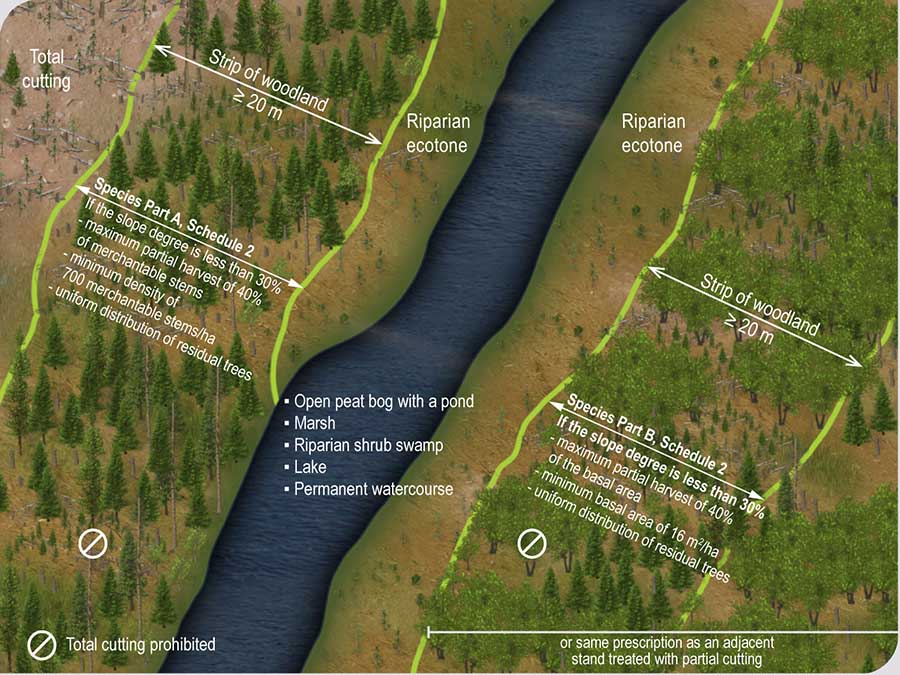Chapter III – Protection of aquatic environments, riparian areas, wetlands and soils
Division II – Open peat bogs (unwooded) with a pond, marshes, riparian shrub swamps, lakes and permanent watercoursess
Section 28
A maximum partial harvest of 40% of merchantable stems, in the case of stands of the species referred to in Part A of Schedule 2, or 40% of the basal area, in the case of stands of the species referred to in Part B of that Schedule, is however allowed in the strip of woodland if the slope degree is less than 30%.
However, the density of the stand may never be reduced to less than 700 merchantable stems/ha, in the case of stands of the species referred to in Part A of Schedule 2, or the basal area may not be reduced to less than 16 m2/ha, in the case of stands of the species referred to in Part B of that Schedule.
Despite the first and second paragraphs, where the sylvicultural prescription provides for partial cutting in the stand adjacent to the strip of woodland referred to in section 27, the harvest level indicated in the prescription for the adjacent stand then applies to the strip of woodland. ![]()
1
Objectives
- To avoid carrying sediment into an aquatic, wetland or riparian environment
- To preserve the integrity of an aquatic, wetland or riparian environment
- To allow for the harvesting of wood
- To ensure the renewal of trees in the strip of woodland
Explanations
Some of the trees in the strip of woodland alongside an open peat bog with a pond, a marsh, a riparian shrub swamp, a lake or a permanent watercourse may be harvested if the slope of the land is equal to or less than 30%. All harvesting is therefore prohibited if the slope degree is more than 30%.
The permitted intensity of harvesting varies by stand type. In the case of a stand composed of the species referred to in Part A of Schedule 2, up to 40% of the merchantable stems may be harvested, provided the density of the stand is not reduced to less than 700 merchantable stands/ha. In the case of a stand composed of species referred to in Part B of that Schedule, up to 40% of the basal area may be harvested, provided the density of the stand is not reduced to less than 16 m²/ha.
However, where partial cutting takes place in the stand adjacent to the strip of woodland on either side of an open peat bog with a pond, a marsh, a riparian shrub swamp, a lake or a permanent watercourse, the harvest level in the strip of woodland must comply with the specifications set out in the sylvicultural prescription of the adjacent stand.
Figure 28 Partial cutting in a strip of woodland alongside a wetland or aquatic environment
The residual trees in the strip of woodland must be spread evenly to ensure the protection of aquatic environments, riparian areas and wetlands.![]()
2
Objectives
- To avoid carrying sediment into an aquatic, wetland or riparian environment
- To preserve the integrity of an aquatic, wetland or riparian environment
- To contribute to the quality of the experience in the forest
Figure 28 Partial cutting in a strip of woodland alongside a wetland or aquatic environment
Total cutting is prohibited in the strip of woodland.![]()
3
Objectives
- To avoid carrying sediment into an aquatic, wetland or riparian environment
- To preserve the integrity of an aquatic, wetland or riparian environment
- To contribute to the quality of the experience in the forest
Figure 28 Partial cutting in a strip of woodland alongside a wetland or aquatic environment

